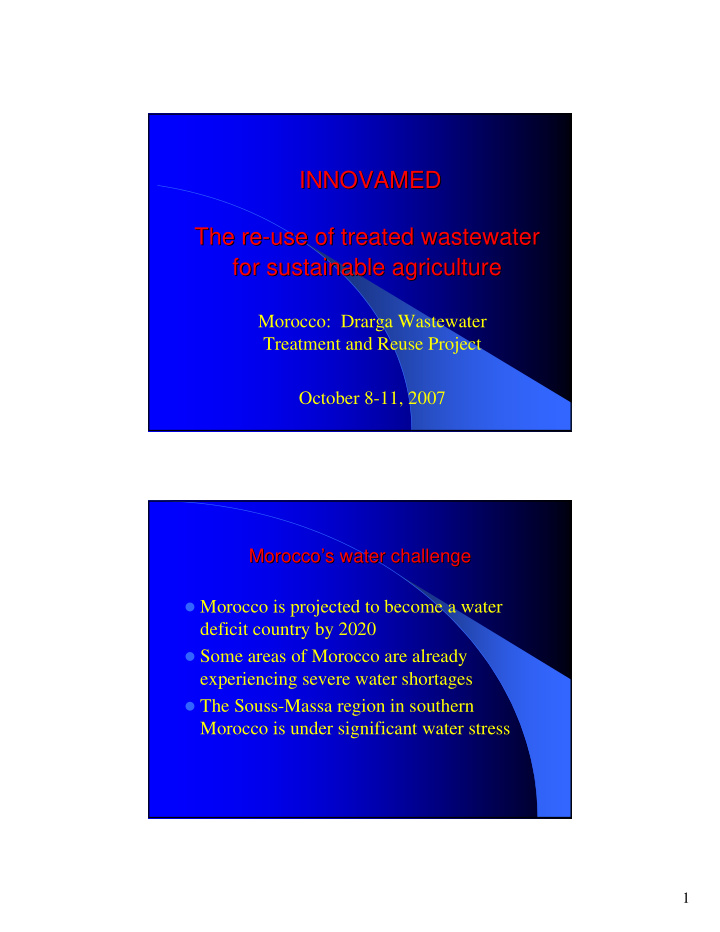



INNOVAMED INNOVAMED The re- -use of treated wastewater use of treated wastewater The re for sustainable agriculture for sustainable agriculture Morocco: Drarga Wastewater Treatment and Reuse Project October 8-11, 2007 Morocco’s water challenge Morocco’s water challenge � Morocco is projected to become a water deficit country by 2020 � Some areas of Morocco are already experiencing severe water shortages � The Souss-Massa region in southern Morocco is under significant water stress 1
The Commune of Drarga Drarga The Commune of � Drarga is a rapidly expanding town in the Souss-Massa (population 10,000) � The town of Drarga has built potable water and sewage collection systems � Raw wastewater was released untreated in nature, creating cesspools 2
Project Objectives Project Objectives � Treat the domestic sewage of Drarga � Reuse the treated effluents for irrigation � Implement a technology adapted to the Moroccan context � Recover the operation and maintenance costs of the plant � Demonstrate a model of institutional partnership 3
Project Steps Steps Project � 1997 : Feasibility study � 1997 : Environmental impact assessment � 1998 : Signature of a collective agreement � 1998 : Observational study tour in the U.S. � 1998 : Plant design � 1999 - 2000 : Construction � October 2000 : Inauguration Institutional Partnership Partnership Institutional � Collective agreement signed between project partners: – Moroccan Ministry of Environment – WRS project (USAID financing) – Wilaya of Agadir – Commune of Drarga – ERAC-Sud � Technical monitoring committee 4
CRITERIA FOR SELECTING CRITERIA FOR SELECTING APPROPRIAT TECHNOLOGY APPROPRIAT TECHNOLOGY � Efficiency and performance of the technology; � Reliability of the technology; � Institutional manageability, financial sustainability; � Wastewater characteristics, � Desired effluent quality which is mainly related to the expected uses Potential cost effective Potential cost effective alternatives alternatives � Stabilization ponds or lagoons, � Sand filters, � Land treatment systems, and � Constructed wetlands 5
Plant design Plant design � Treatment capacity : 1000 m 3 / day � Recirculating sand filtration system – Primary treament: anaerobic basins – Secondary treatment: sand filters – Tertiary treatment: reed beds � Residual sludge drying beds � Treated effluents storage basin Drarga wastewater treatment process wastewater treatment process Drarga Recycle Sand filters Sand filters Pump station Anaerobic Basins Reed Screen Beds Denitrification Regulation sludge leachate basins basins Sludge drying Storage bed basin Water for Dried sludge for irrigation compost 6
View of the wastewater treatment plant Anaerobic basin 7
Denitrification basin 8
Sand filters 9
Maintenance of sand filters Maintenance des filtres à sable Canalisation d’eaux traitées Re-circulation of effluents 10
Reed beds Storage basin 11
Office and laboratory Plant performance Plant performance Indicator BOD 5 COD TSS NTK Fecal (mg/l) (mg/l) (mg/l) (mg/l) Coliforms (mg/l) 6.3x10 6 Entrance 625 1825 651 319 10 3 Standard <30 N/A <30 N/A Exit 10 75 3.9 10.2 <500 12
Project Costs Project Costs � The project cost is $1 million – Studies : $150,000 – Design : $100,000 – Construction : $400,000 – Equipment : $250,000 – Transportation : $100,000 � Operating costs : $1,000 per month Cost recovery recovery Cost � Methane gas is recovered from the anaerobic basins and converted to energy � Treated wastewater is sold to farmers for irrigation � Reeds are harvested and sold � Residual sludges will be dried and used with organic solid wastes from Drarga to make compost 13
Wastewater reuse reuse Wastewater � Treated effluents are sold to farmers through a water users association � Treated effluents contain fertilizer elements (potassium, phosphorous) � The price of the treated wastewater is competitive with alternative water sources Reuse Perimeter Reuse Perimeter � Area : 6 hectares � Farmers : 12 � Soil texture : sandy loam (risk of nitrate infiltration) � Irrigation system : surface, microjet and drip 14
Zucchini 15
Tomatoes Maize 16
Impact of reuse Impact of reuse Biomass Yield Yield of the Total yield Average Yield 1 st cut yield (T/ha) California- (T/ha) (T/ha) Davis (T/ha) Alfalfa 2.85 28.5 14 31 Italian 9.75 48.7 21 - Ray- Gras Fertilizer savings Fertilizer savings Tomato Zucchini Alfalfa Italian Wheat Maize Ray Grass Water 8 000 5 000 12 000 10 000 4 000 4 800 Requirements (m3/ha) Nitrogen 248 155 372 310 124 149 (kg/ha) Phosphorous 352 220 528 440 176 211 (kg/ha) Potassium 408 255 612 510 204 245 (kg/ha) 17
Project Impact Project Impact � The town of Drarga has full sewage treatment � There is more water available for irrigation � Crop yields have increased and farmers are saving on fertilizer applications � Property values in Drarga have increased � The project has generated a lot of interest from other localities in adopting similar technologies 18
Conclusion Conclusion � The Drarga wastewater treatment and reuse project is demonstrating the use of non- conventional water sources in a water scarce environment � This project and the lessons learned from it can serve as a useful model for replication of similar technologies and approaches in many areas 19
Recommend
More recommend